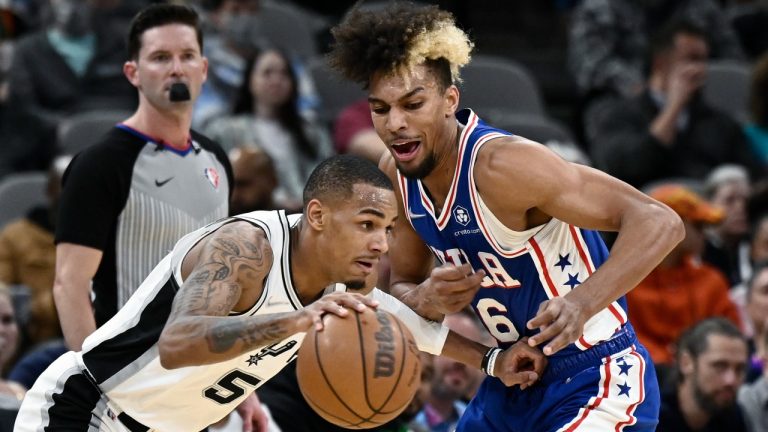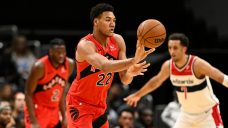When the NBA created the new, stricter roster construction rules for luxury tax teams in the collective bargaining agreement, they probably didn’t care much about the impact it could have on G League teams. Yet it’s one of those “apron” rules that may have helped Raptors 905, Toronto's G League affiliate, secure a foundational piece in Charlie Brown Jr., once training camp had already begun.
Brown, a five-year G League veteran with a few cups of coffee in the NBA, now figures to be one of the most important 905ers, offering size and shooting from the wing and sliding into a leadership role at age 27. His availability is not something the 905 could have planned for until very recently. Changes to Brown’s outlook — and the Raptors’ NBA and G League outlook — shifted at fortuitous times to make this a strong fit.
To get here, Brown had to go through a whirlwind couple of weeks, a whirlwind he was paid handsomely for.
In late September, the New York Knicks and Minnesota Timberwolves agreed to a trade framework to send Karl-Anthony Towns to Gotham for Julius Randle and Donte DiVincenzo. Those were the broad strokes, but the CBA rules made executing such a deal extremely complicated.
Both the Knicks and Wolves were over the “first tax apron,” meaning neither could take back more money than they sent out. That meant the salaries in the trade would either have to match to the penny, or they’d have to loop in a third team to make the math work. The Charlotte Hornets were willing and picked up three second-round picks (and the cash to cover the contracts) to take on Duane Washington Jr., DaQuan Jeffries, and Brown.
Brown’s father sent him an Instagram report of the Towns-for-Randle part of the deal, and it was only after those initial reports surfaced that Brown’s agent, Andre Buck, told him to stay tuned.
“It was very interesting,” Brown said, laughing, calling it an even trade for the Wolves and Knicks. “I found out after. My agent told me the trade was going to happen, I didn’t know I was going to be involved in it (at first).”
The machinations are complicated. All three players signed three-year deals with one year fully guaranteed (mandatory for a sign-and-trade deal), and all three received a dollar over their minimum to circumvent a rule about aggregating minimum contracts. The Knicks still held rights on all three players, allowing them to be signed and traded for more than the minimum. The Hornets would have to actually pay the players their first-year salaries, and in Washington’s case, he had to receive FIBA clearance in a series of paper transactions in both Europe and the NBA. It goes on and on.
In Brown’s case, he finished last season on a two-way deal with the Knicks. While they didn’t tender him a qualifying offer to make him a restricted free agent, they still held Non-Bird Rights on him, leaving open this sign-and-trade possibility. The decision to accept being a part of the trade was pretty straightforward; Brown was going to be paid $2.2 million to agree to be sign-and-traded and, likely, waived by the Hornets afterward.
Before the trade, Brown was expected to head to training camp with the Orlando Magic after spending Summer League in their program, and in Singapore as part of the G League’s international showcase team. The Hornets were upfront with Brown that they had invested in other young players and were unlikely to keep him after the trade, and while he did stick around camp for two weeks and appear in four preseason games, they ultimately waived him.
That left Brown in an interesting position with no shortage of suitors. Had the Knicks trade not come along, Brown could have taken higher-paying overseas offers more seriously. Now, with $2.2 million already earned for the year, a $41,500 G League salary was a sacrifice that was easier to stomach to stay close to the NBA.
“A lot of overseas teams were pursuing me, but my agent said, ‘be patient.’ I just waited it out and kept working,” Brown said, acknowledging the financial component of the decision “absolutely” changed after the trade.
Raptors 905 pitched Brown on the opportunity not only to play a big role in the G League, but also showcase himself to NBA teams, including the rebuilding Raptors.
Since he technically had four years of NBA experience (though just 407 minutes played, in total), Brown is no longer eligible for a two-way contract. Brown can be signed out of the G League at any time, but players in his position normally become targets in January, when teams can sign players to 10-day contracts (Brown would earn roughly $129,000 on any 10-day deal). Shooting is always at a premium in the NBA, and a strong first half of the season with the 905 should have Brown near the top of the call-up list for wing players. A big role with a quality program, as the sales pitch goes, presents a path back to the NBA.
Once Brown was on board, the 905 dealt a future first-round pick, two future second-round picks, and the rights to Marques Bolden to acquire his rights. Brown hopped on a flight to Toronto and joined the 905 early enough in training camp that he should hit the ground running under new head coach and fellow Philly native Drew Jones.
“After that trade, I don’t know what’s going on, I don’t know where I’m going to go, what I’m going to do,” Brown said. “(My agent) said 905 was really interested. I talked to Drew Jones, and him being from Philly, that’s all I really needed. We had a conversation on the phone. He was like, ‘Yo, you know how to play, we need you to lead and just do what you do.’ He made me feel very, very comfortable coming into this.”
It's one of the more interesting places a player can find themselves in. Brown’s been one of the best players in the G League for five years across four teams, earning five different NBA opportunities. Including Summer League, pre-season, and G League programs, Brown’s been a part of nine different NBA organizations. There are always teams interested, given his size and skill set. Yet in none of these stops has Brown gotten much of a chance to actually play at the top level (though, it should be said, he’s shot poorly in those small windows).
Being a part of the Towns trade made it financially feasible to take another shot at the G League, where he’ll look to prove he’s not a “Quad-A” type who is stuck between the highest levels of the minors and the NBA.
“To be honest, whether I’m here or somewhere else, I love to play basketball,” Brown said. “I’ve been playing since I was four years old. It’s easy. I don’t look at it as a job. Any type of basketball, NBA, G League, or somewhere else, I’m gonna work my hardest.”
Raptors 905 season-opener notes
• The 905 open their season Saturday in Delaware, the first contest of a five-game road trip. They then return home for a seven-game homestand, beginning Nov. 22 in Mississauga, Ont., and including a Dec. 5 morning game at Scotiabank Arena.
• D.J. Carton and Ulrich Chomche are the two-ways currently with the 905, though Carton could be pulled from Saturday’s opener due to how many injuries the NBA Raptors are dealing with. Carton and Battle, who's stuck around with the big club, should see at least semi-regular 905 time, while Chomche will be with the 905 on a more permanent basis. Drafted rookies Jamal Shead, Jonathan Mogbo, and Ja’Kobe Walter could also see time.
• Tyreke Key and Evan Gilyard beat out Vance Jackson Jr., Charles Pride, Chris Vogt, and Devonte Bandoo for the final two roster spots. Key was a “local tryout player” the 905 had identified in Belgium last season, and who shot the ball incredibly well in camp (at least according to Brown). Gilyard, meanwhile, was technically a returning rights player acquired in trade, but he’d first impressed the 905 at the actual tryouts this summer.
Guards: D.J. Carton (two-way), Kennedy Chandler (Ex. 10), Tylor Perry (draft), Evan Gilyard (trade), Tyreke Key (tryout)
Wings: Jamison Battle (two-way), Charlie Brown Jr. (trade), Myles Burns (rights)
Forwards: Dylan Disu (Ex. 10), Quincy Guerrier (Ex. 10), Kevin Obanor (rights; Ex. 10)
Bigs: Ulrich Chomche (2-way), Branden Carlson (affiliate)
Assignment eligible: Ja’Kobe Walter (was in training camp), Jamal Shead, Jonathan Mogbo, Gradey Dick, Ochai Agbaji
• There could be an opportunity for one of the players cut to be back with the 905 in a couple of weeks.
Quincy Guerrier will be leaving the 905 from Nov. 17-24 to play for Canada in a pair of FIBA AmeriCup qualifiers in Saskatoon. Guerrier Is one of 15 players on a pretty loaded camp roster, by the standards of in-season national team games, and could have a sizable role under coach Nathaniel Mitchell (formerly a Raptors and 905 assistant). Guerrier has appeared for Canada in the U17 World Cup and Globl Jam in the past but this will be his debut with the senior team.
Canada plays the Dominican Republic (Nov. 21, 8:10 p.m. ET / 5:10 p.m. PT) and Mexico (Nov. 24, 3:10 p.m. ET / 12:10 p.m. PT). Both games will air on Sportsnet. This is the second of three qualifier windows that lead to the 2025 FIBA AmeriCup.
• According to numbers from the NBA, 51 per cent of players on opening night NBA rosters have played in the G League, along with eight head coaches. It’s never been more necessary to run a strong G League program, and never been more acceptable for prospects — even lottery picks — to get some additional seasoning for a handful of games or more.
• 905 general manager Luke Winn joined us on The Raptors Show this week to discuss the team and the season ahead. Check it out! We got into some individual player notes, how the 905 works to maintain synergy with the NBA club, and where the two teams may differ due to personnel and roster construction.







COMMENTS
When submitting content, please abide by our submission guidelines, and avoid posting profanity, personal attacks or harassment. Should you violate our submissions guidelines, we reserve the right to remove your comments and block your account. Sportsnet reserves the right to close a story’s comment section at any time.